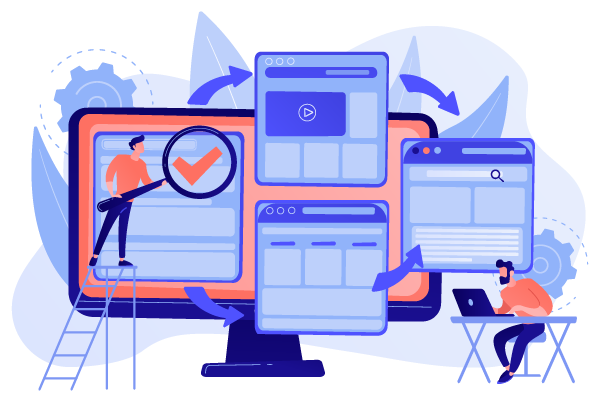Web App Development

Web-based applications are a silver bullet. They can run on any device that has a built-in browser: a desktop, laptop, chromebook, smartphone, or a smart device with a browser like a smart fridge. With the development of wearables and Internet of Things (IoT) devices, the power of web apps will keep growing. And the best part? The cost of developing a web app is much lower than the cost of developing either a native or hybrid app.
What are Web Apps?
To put it simply, web apps are applications (or programs) built to run from a web browser (Safari, Chrome, FireFox, Edge, etc). Some examples of popular web apps users use everyday are YouTube.com, Facebook.com, Canva, Google Office Suite (Google Docs for example), Amazon.com, and the Web versions of Gmail, Yahoo Mail, Outlook just to name a few.
The major part of modern websites are web apps, and any component of the website that provides service may be qualified as a web app.
Benefits of web-based applications
No installation required. To visit a web app, you need to take a single step: enter the web app’s URL in the address bar. Another way is to go to Google, enter the website’s name, and click on a link. That’s it. To attract users who’d like to avoid installing new apps, consider a web application for your business.
Multiple users – same version of a product. While well-established companies can allocate resources to support app’s previous versions, startups may find it rather difficult. As soon as a new OS version rolls out, the development team may lack resources to support some of the older versions. Users of older OS versions notice that something went wrong, experience lags, bugs, or other issues, and delete an app. On a web app, there are no such problems. No matter how often the team updates the product, all users across all platforms can see the same result and can use the latest version. It simplifies management and support: the team doesn’t have to worry about users unable to update an app. There’s no need to send personalized notifications or emails to remind users of upcoming updates.
Multiple users – same functionality and design. Same apps on Android and iOS may look and work differently. Different system requirements, different development approaches and technologies, drop by drop, contribute to vivid contrast of designs. Starting from minimum tap target size to lists, navigations, and CTAs, apps may look different. Switching from Android to an iOS device or vice versa, mobile app users may experience inconvenience or notice some new screen elements. In the case with web apps, it is not going to happen. Web applications may have constraints, but they look the same for all users.
| Simple | Medium | Complex | Innovative | |
|---|---|---|---|---|
| Price | Starting At$3,000 | Starting At$15,000 | Starting At$60,000 | Starting At$250,000 |
| Financing Available* | ✔ |
✔ |
✔ |
✔ |
| Turnaround Time** | 3-6 Weeks | 6-18 Weeks | 18-25 Weeks | 6+ Months |
| API Integrations | ✔ |
✔ |
✔ |
✔ |
Disclaimers
* Financing available through in-house financing and third party lenders. Subject to credit and availability. Not all customers will qualify for financing options.
** Turnaround time displayed is the estimated avarage. Actual turnaround time will vary based on the project scope, customer response time and approvals. All deadlines are mapped and scheduled during the project consultation.
Third-party logos and marks are registered trademarks of their respective owners. All rights reserved.

